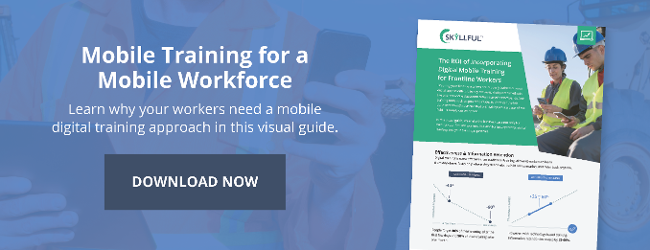Does your team waste time training and re-training? Or worse, is your team unable to do their jobs effectively due to poor training? Traditional (read: old school) methods like one-and-done classroom training aren’t effective for these workers. Static tools, such as PowerPoint slides aren’t impactful and pulling workers out of the field for training is expensive and wasteful.
Many organizations see the problem but don’t realize there is an alternative—or they don’t supplement their training offerings because they don’t want to put more money toward the issue without knowing there will be results. This blog will explore the benefits of incorporating digital training and, specifically, the return on investment field service organizations see.
Effectiveness
As we’ve discussed in the past, adults approach learning differently than children. The Theory of Andragogy by Malcolm Knowles is a popular approach. To summarize Knowles, adults want learning to be more self-directed, task-oriented, problem-centered, experiential, and hands-on. Digital mobile training delivers all those benefits.
Digital is more effective than traditional training, particularly when delivered via mobile. With digital training, individuals:
- Can learn from anywhere
- Focus only on the content they need (skipping what they already know, saving time)
- Use app simulations for scenario-based training
- Train in real-time in their job scenarios for hands-on learning
- Increase their information retention
Less downtime
Digital is much more efficient and faster than traditional training. There may still be some up-front classroom training, but this is greatly reduced. From there on, the training tools needed are available when and where needed. This makes it easier for workers to learn on the job and fit training into their schedule, leaving little to no downtime.
As a result of this efficiency, new employees are able to get up to speed quicker, productivity is increased throughout the workforce, and workers can adopt new digital solutions quicker.
To make training more accessible for all its employees, one company decided to provide compliance training on mobile in addition to computers. Of those who took the mobile course:
- 99% said it was the best way for them to learn
- They finished the course 45% faster than those on computer
- The company saved 4,270 hours of productivity by offering mobile learning
Reduced turnover
Workers want to be properly trained and are willing to switch jobs due to poor training.
- Among employees with poor training opportunities, 41% planned to leave the company within a year
- Of those who had excellent company training opportunities, only 12% planned to leave
- New employees are 42% more likely to stay when receiving the training they need
Turnover is already a concern for field service organizations, so it’s important to get workers up to speed fast and make them feel satisfied in their roles. Incorporating digital training is a perfect way to do this.
ROI
While digital training may have a higher upfront cost (and this isn’t even always the case), it’s far less expensive and more scalable long-term over traditional training.
- Companies that invest $1500/employee on training see an average of 24% more profit than companies who invest less
- An increase of $680/employee on training generates an average 6% improvement in shareholder return
- Technology-based training is up to 90% less expensive than instructor-led training long-term
In summary, we recommend incorporating digital training into traditional training. As detailed above, from the increased effectiveness to reduced downtime and turnover, the benefits are immense.
Take a deeper dive into the ROI of digital training with this visual guide . And if you’re looking for a digital training solution for your field workers, check out the first digital adoption platform designed specifically for frontline workforces, Skyllful.


